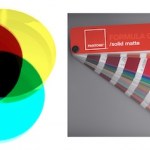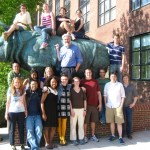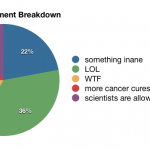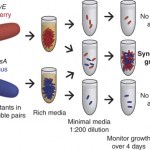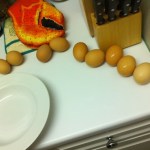friends
Last month I wrote about my friend Devin Burrill's paper about synthetic memory in yeast cells. There were a lot of really interesting questions left in the comments, and I asked Devin if she would write a guest post to answer them. She agreed and here it is, answers to your questions straight from the author!
Hello Readers!
My name is Devin, and I am so incredibly grateful to Christina for allowing me to write an entry on her awesome blog. Christina and I are friends and work together in the lab of Pamela Silver at Harvard Medical School. I am writing in response to a number of excellent…
Cells permanently change their behavior in response to temporary changes to the environment, a kind of biological memory that controls processes as important and complex as how stem cells differentiate into specific tissues or how the immune system "remembers" dangerous pathogens. At its simplest, cellular memory is achieved with a positive feedback loop--once activated by some external signal, the feedback loop will continually activate itself, even as the cell divides and the signal is taken away. In synthetic biology we can recreate such simple feedback loops, genetic circuits built of…
I recently learned that one of my advisors and mentors is not only a great scientist, but also a poet. This poem was written a few years ago for his biotech company's clean-up day poetry contest and won him a $5 gift certificate to Dunkin Donuts. I think it's actually quite good and deserves more attention than that so I'm reproducing it here, with permission from the author.
Squeal by Jeff Way (with apologies to Allen Ginsberg):
I saw the best minds of my generation destroyed by cleanliness, crazed drooling wrapped in lab coats, dragging themselves through the late-night fluorescent…
Synthetic biologists work on designing living cells, but engineered bacteria don't usually come up when you think of "designer" things. This year however, a synthetic biology design is up for a Brit Insurance Design of the Year award, up against the Lanvin Spring collection, Angry Birds, and Rock Band 3! Designers Daisy Ginsberg and James King worked in collaboration with the 2009 Cambridge iGEM team (including awesome blogger Lab Rat) to imagine ways that people could use bacteria engineered to produce pigments in the future. Check out their video about the science and design of E. chromi:
Scientists aren't known for their fashion sense, but they do have their own unique charm, as you can see in this episode of In The Lab, with Bill Cunningham.
What do you get when you combine two of my favorite things, synthetic biology and documentary film? We may never know if Sam and George don't get the funding they need on Kickstarter!
I don't usually do this kind of thing, but I met these guys while they were filming in Boston and their movie promises to be really good and really interesting and really educational (and I might even be in it!). You can check out some of their videos from the road on their vimeo page, including this one from the University of Wisconsin iGEM team:
My friend Patrick is embarking on a 48 experiment, studying circadian rhythm and destroying his own in the process. He's also embarking on a social media experiment, live-streaming the whole thing on ustream.
Tune in to watch real science in action and the effects of sleep deprivation on scientists! You can even ask him questions during the three hours between experimental time points!
We can babble philosophically about whether or not what we call "red" looks the same from another person's eyes, we can compare the adjectives we use to specify colors--is it maraschino red or cayenne?--but when we're talking to our computers, categorizing flowers, designing objects for mass production, branding a company, or establishing a flag's official colors we have to be able to be specific about which exact shade of red we want.
These days we have standard color systems that define colors as specified mixes of red, green, and blue pixels on screen, specific mixtures of pigments in…
Mammalian cells need something to hold on to before they can stick to each other and form tissues. The plastic dishes that cells grow on in the lab need to be first coated with special chemicals that grab the cells and convince them to stick. Once the first batch of cells is down they start forming their own matrix of proteins and fibers that can grab new cells as they are formed, slowly creating a dense layer of cells. Tissue engineering aims to make three dimensional, biodegradable scaffolds that cultured cells can grow on to form body parts, like the ear-shaped bit of cow cartilage that…
It's not just Scott Kern who thinks that science is only about tedious benchwork and that grad students should be boring robots moving small volumes of liquid around 20 hours a day for the greater good. An unscientific analysis of the 169 comments and numerous comment thumbs ups of Hydrocalypse Industries' most popular video shows that a significant percentage of the commenters who aren't saying something completely inane, off topic, or conspiracy-theory laden are criticizing us for not working hard enough.
I hopefully don't need to go into detail about how many hours we are all actually…
iGEM students are nothing if not creative, fun, and super nerdy. Here is a taste of some of the awesome videos being made by this year's crop, enjoy!
Cambridge, with a catchy song about new techniques for joining pieces of DNA together:
(via LabRat)
Hong Kong University's Inception trailer:
TU Delft, finding science in pop music:
And of course, Harvard, being dramatic in the lab:
Our friends at Ginkgo BioWorks are hiring and they asked Hydrocalypse Industries to make them a video! Who Is the Bioengineer of the Future?
It could be you!
The new season of Science in the News starts next week with a great schedule of science lectures by Harvard grad students free and open to the public. If you're in the Boston area, definitely check it out!
Here's the schedule:
September 22: Evidence-based Medicine: A Case Study of Vaccines and Autism
September 29: Bots That Mimic Bugs: Flying, Crawling, and Squishy Robots
October 6: You Are What Your Mother Ate: The New Science of Epigenetics
October 13: Beyond Agribusiness: New and Old Ways to Grow Food
October 20: The Laser Turns 50: A Brief History and New Frontiers
October 27: Forget-Me-…
My good friend and labmate just published an awesome paper: "Emergent cooperation in microbial metabolism." His experiment started with 46 strains of E. coli that had mutations in their metabolic pathways that prevented them from being able to grow without supplementing the media with extra metabolites. Alone they died, but grown together in the same tube, many pairs of mutants were able to feed each other the missing metabolite. Metabolic cooperation was the key to survival.
Measuring and understanding metabolic cooperation can be used to build stronger, more predictive models of…
Science is cooking done in a lab. Mixing carefully (or not so carefully) measured components, heating, cooling, observing phase transitions, exploring the behavior of animal and plant proteins, exploring the properties of different chemicals, slowly changing variables to optimizing procedures. Often, feeding bacteria has a lot in common with feeding people, and I have to admit that freshly autoclaved yeast media smells delicious.
Said another way, cooking is science where at least you can usually eat the failures. My fiancé and I have been failing at making soft-boiled eggs for quite some…
The World Science Festival starts today in New York City with tons of exciting events from BioArt to The Science of Star Trek and all sorts of great stuff in between! If you can't make it to New York there's also a twitter page and a blog here on ScienceBlogs accompanying the event that you can follow along with, and I had the chance to write a post over there about how I got into science as a kid. So go check it out! "What if Science Were Like Sports?" Here's a little teaser:
There is big excitement in lab today--my very talented labmate Jake has won the Division of Medical Sciences graduate student science haiku contest!!! Here is his burrito winning entry:
Green lasers on high
Shining to illuminate
Synechococcus!
It's definitely haiku day over here, so share your science haikus in the comments for maximum fun!
This is a pretty old video we made about Craig Venter that I've shared before on Hydrocalypse, but I think now is a good time to share it again. When Craig isn't creating synthetic bacteria, he's sailing the world, searching the oceans for interesting DNA sequences. We were inspired by this lifestyle (and sometimes even his science too) and SNL, and from that came Venter's on a Boat, by Hydrocalypse Industries (warning: the song contains a lot of bad language):
Silks are incredible protein fibers produced by many different species of insects. Besides their use in making versatile textiles, silks are currently used in many different medical and engineering applications, from sutures to tissue engineering scaffolds to flexible electrode brain implants. Since I love fabrics and I'm interested in what biological engineers can do with biomaterials, I recently started working on a fun side project to raise and engineer silkworms, the animals used in industrial silk production around the world. We're having a lot of fun learning about silk and how to raise…
Many people in synthetic biology, including myself and much of my lab, are working on using biology to make things more efficiently, renewably, and sustainably. Being able to make plastic replacing biomaterials, chemicals, medicines, and fuels in living cells from renewable resources (especially in photosynthetic organisms that need only sunlight and water) will undoubtedly decrease our dependence on fossil fuels and with a lot of work in policy and process and infrastructure engineering may one day become truly sustainable. It's difficult to not notice, however, how unsustainable most…

